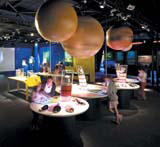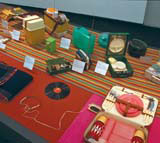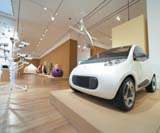The art of showing off
Creating displays for very disparate or unusual subjects can prove an interesting challenge for exhibition designers. Pamela Buxton investigates how the issue was approached in three recent major exhibitions from around the world.

Creating displays for very disparate or unusual subjects can prove an interesting challenge for exhibition designers. Pamela Buxton investigates how the issue was approached in three recent major exhibitions from around the world
Faced with objects of all shapes and sizes, both real and virtual, the designer of an exhibition, of a conceptual slant, is presented with an interesting challenge. Sure, there’s no danger of monotony, but this is tempered with two problems. First, the sheer logistical difficulties of accommodating outsized or awkward exhibits, such as the tree tent that led the Museum of Modern Art to reinforce a wall in the show Safe/ Design Takes on Risk. And, second, there’s the aesthetic and intellectual challenge of providing a cohesive environment that allows a narrative to emerge from disparate raw material. It’s a problem that any good designer relishes, as demonstrated by these three case studies from the US, Switzerland and the UK.
The Science of Aliens
Science Museum, London, until 28 February, then touring. Designed by Urban Salon, with graphics by Bibliothèque
The Science of Aliens (pictured above) presented a double challenge to design group Urban Salon. Not only was it dealing with exhibits as unwieldy as a 1930s diving suit and a huge model of the Alien Queen from the film Alien, but it had to get to grips with a highly abstract and scientific subject, requiring all the help it could get from its presentation.
‘We had to make the environment work quite hard for us, to help in communicating the storylines,’ says Dee Halligan, project director at the Science Museum. The result, says Diana Cochrane, head of interior design at Urban Salon, is diverse presentations, ranging from traditional, 19th century-style museum display, to cutting edge interactive elements, used to create amazing fictional alien worlds. These are united by a dark, immersive atmosphere, assisted by dramatic lighting and edge-lit acrylic caption-holders.
Displays include a ‘cute and cuddly’ wall of different-sized acrylic tubes, containing toys, such as ET, based on the idea of a toyshop. Another section has four laboratory-style display tables, designed around content on the search for alien life on other planets. Alien-like specimens are displayed in bright blue aluminium tubes, while suspended above are large-scale models of planets and moons. These complement the interactive virtual landscapes (designed by Art & Com), presented on curved vinyl-coated MDF surfaces.

Take Away – Design for Eating on the Move
Museum of Design, Zurich, until 19 March. Designed by Alfredo Häberli
Take Away, an exhibition of the history and paraphernalia of convenience eating, starts with a picnic and ends with the issue of littering. The circular, physical path for the narrative is three, 10m-long bespoke display tables, undulating through the space with a verve that matches the fast-paced subject matter.
The design concept, by Zurich-based designer Alfredo Häberli, is flexible enough to house 350 exhibits, ranging from a 17th century lunch box for a Swiss farmer, to the large-scale food storage units of an aeroplane.
‘We could easily adapt this landscape to what we wanted, putting bigger exhibits lower down and smaller ones up very high, so that the huge objects don’t kill the smaller objects,’ says exhibition project manager Norbert Wild. ‘We needed a strong device, otherwise you’d just have a mixing up of everything and it wouldn’t be clear what you want to talk about.’
At the ends of the tables, screens are inset to illustrate footage, including picnic scenes from the 1950s and information on astronauts’ eating habits. In addition to the tables, the gallery walls are also used to display groups of 2D objects.
The tables were made by the museum and covered in Kvadrat fabric, in different colours, to evoke the picnic theme.

Safe: Design Takes on Risk
Museum of Modern Art, New York. Designed by in-house production manager David Hollely
A series of low MDF platforms was the unifying concept for most of the 300-plus exhibits in Safe: Design Takes on Risk, an exhibition of objects for protecting mankind in emergency situations. Exhibits ranged from Shigeru Ban’s paper log house to a single-use earplug, and were arranged in six themes, including shelter, emergency and armour.
‘We wanted this long, uninterrupted plane that pulled you through the space,’ says designer David Hollely, adding that, as a durable, lightweight surface, MDF was preferable to plywood in achieving the flat, even look they were after. Not only is it less likely to warp, it is similar to the colour of the floor and the walls. ‘We wanted the colour to read as a generic warm body,’ says Hollely. Curator Paola Antonelli adds that they avoided clichéd danger colours, such as black and orange, and went for neutral instead, to give visitors the feeling that they were inside a ‘big toffee’.
Exhibits are mostly placed directly on to the platform, housed in cases on the platform, or displayed on 60 MDF cut-outs of people. This design device shows how exhibits could be used, while the figures’ stylised, 2D nature makes them sufficiently distinct from shop mannequins – crucial, since many of the exhibits could be bought in shops and the exhibition team was keen to avoid a retail-style environment. For security, some of the smaller objects were displayed in cases, recessed into the exhibition walls and integrally lit. l
-
Post a comment




